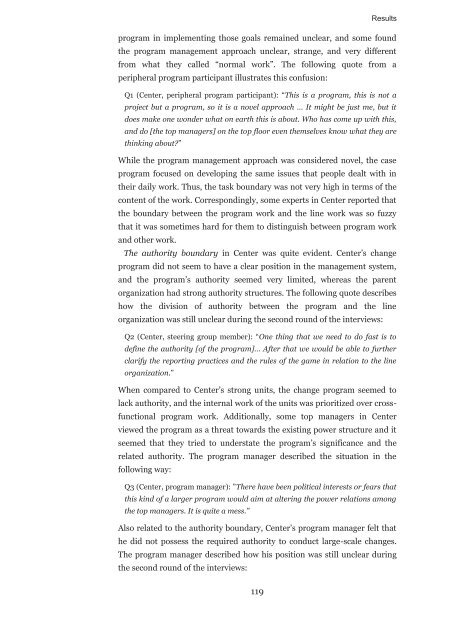Boundary activities and readiness for ... - Projekti-Instituutti
Boundary activities and readiness for ... - Projekti-Instituutti
Boundary activities and readiness for ... - Projekti-Instituutti
You also want an ePaper? Increase the reach of your titles
YUMPU automatically turns print PDFs into web optimized ePapers that Google loves.
Results<br />
program in implementing those goals remained unclear, <strong>and</strong> some found<br />
the program management approach unclear, strange, <strong>and</strong> very different<br />
from what they called “normal work”. The following quote from a<br />
peripheral program participant illustrates this confusion:<br />
Q1 (Center, peripheral program participant): “This is a program, this is not a<br />
project but a program, so it is a novel approach … It might be just me, but it<br />
does make one wonder what on earth this is about. Who has come up with this,<br />
<strong>and</strong> do [the top managers] on the top floor even themselves know what they are<br />
thinking about?”<br />
While the program management approach was considered novel, the case<br />
program focused on developing the same issues that people dealt with in<br />
their daily work. Thus, the task boundary was not very high in terms of the<br />
content of the work. Correspondingly, some experts in Center reported that<br />
the boundary between the program work <strong>and</strong> the line work was so fuzzy<br />
that it was sometimes hard <strong>for</strong> them to distinguish between program work<br />
<strong>and</strong> other work.<br />
The authority boundary in Center was quite evident. Center’s change<br />
program did not seem to have a clear position in the management system,<br />
<strong>and</strong> the program’s authority seemed very limited, whereas the parent<br />
organization had strong authority structures. The following quote describes<br />
how the division of authority between the program <strong>and</strong> the line<br />
organization was still unclear during the second round of the interviews:<br />
Q2 (Center, steering group member): “One thing that we need to do fast is to<br />
define the authority [of the program]… After that we would be able to further<br />
clarify the reporting practices <strong>and</strong> the rules of the game in relation to the line<br />
organization.”<br />
When compared to Center’s strong units, the change program seemed to<br />
lack authority, <strong>and</strong> the internal work of the units was prioritized over crossfunctional<br />
program work. Additionally, some top managers in Center<br />
viewed the program as a threat towards the existing power structure <strong>and</strong> it<br />
seemed that they tried to understate the program’s significance <strong>and</strong> the<br />
related authority. The program manager described the situation in the<br />
following way:<br />
Q3 (Center, program manager): ”There have been political interests or fears that<br />
this kind of a larger program would aim at altering the power relations among<br />
the top managers. It is quite a mess.”<br />
Also related to the authority boundary, Center’s program manager felt that<br />
he did not possess the required authority to conduct large-scale changes.<br />
The program manager described how his position was still unclear during<br />
the second round of the interviews:<br />
119









